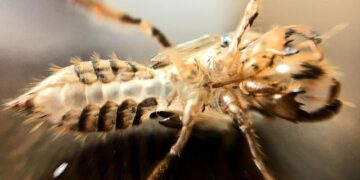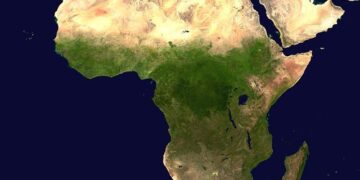ScienceThe Big Idea
When an astronomer discovered a brief bolt of energy that could travel billions of light-years, he was astonished. Then decades went by without evidence of another.
ByJoe Palca
Published July 13, 2023
• 8 min read
If a scientist sees a unicorn, she’ll probably want to see more than one before telling the world about her discovery.
But sometimes one unicorn is enough.
In 2007 an astronomer named Duncan Lorimer reported finding a spectacular new kind of celestial event. It was a brief bolt of energy so powerful it could reach Earth from a galaxy billions of light-years away. He called his discovery a fast radio burst (FRB), because it lasted less than a second and it was only detectable using a radio telescope.
It was a remarkable find. If real, FRBs could be used to measure the amount of matter in the space between galaxies. I likened them to a kind of dipstick for the density of the universe—a turn of phrase my editor loved that also happens to be accurate.
The problem was, Lorimer found only one of these spectacular new events. He predicted there would be many more—but in 2007 he spotted just one.
It’s not unheard of for one event to kick off a whole new field of scientific inquiry. A fragment of a pinkie bone found in a cave in Siberia allowed anthropologists to infer the existence of an entire population of humans who walked the Earth around the time of the Neanderthals.
Still, it’s rare.
When Lorimer’s paper came out in the journal Science, I was a science correspondent at NPR. Even though I did a segment about Lorimer’s discovery on the afternoon program All Things Considered, I was skeptical. It showed in this sentence from my report for that broadcast: “Sometimes, what seems like a remarkable scientific discovery turns out to be an error in the data.”
Were these so-called Lorimer bursts, as some sarcastically referred to them then, just a technical glitch?
The glitch explanation gained momentum from a paper by a young graduate student named Sarah Burke-Spolaor. Her thesis adviser assigned her the task of finding more FRBs. Using observations taken by the radio telescope at the Parkes Observatory in Australia, the same radio telescope Lorimer used to detect his FRB, she found more bursts that looked like FRBs. But because of the way they appeared in the telescope data, she was virtually certain what she was seeing was some kind of Earth-based radio interference. Although what was causing these events was a mystery at the time, she gave them a name: perytons.
The peryton explanation
Please be respectful of copyright. Unauthorized use is prohibited.
Illustration by Eric Thompson
The Parkes Observatory radio telescope has one antenna with 13 separate feed elements, each pointing at a slightly different part of the sky. Normally, a signal from a celestial object will appear in just one of the feed antennas, or another if it’s really strong. But a signal that appears in all 13 is what astronomer Evan Keane calls “rubbish.” By that he means it’s most likely radio interference from a source such as a leaky power line, lightning, or even a cell phone.
Now at Trinity College Dublin, Keane was conducting research at the Parkes Observatory when Sarah Burke-Spolaor reported radio astronomical signals there—and Keane was pretty sure that was rubbish.
Burke-Spolaor said she observed multiple phenomena like the fast radio burst that Lorimer identified, but they also appeared in the telescope as Earth-based interference might. She decided to name the signal after “something that was both natural and man-made”—and chose peryton, a mythical creature that looks like a deer with wings but casts the shadow of a man, according to Jorge Luis Borges’s Book of Imaginary Beings.
The breakthrough in determining the real source of perytons came in early 2015. An instrument installed at the telescope to monitor ground-based interference detected three bursts of it at the exact time the radio telescope recorded three new perytons.
A bit of sleuthing revealed the source. Investigators were able to re-create the peryton signal—by opening the door of the staff kitchen’s microwave oven before the cooking cycle finished. That explains why most perytons were seen after the normal lunch break was over, Burke-Spolaor says: “These were people who were really hungry,” impatient, and unwilling to wait.
So, a putative celestial object, it turns out, had less to do with humanity’s quest for knowledge than the quest for lunch. —JP
As the years ticked by and no more FRBs were discovered, some astronomers began to conclude Lorimer had found nothing more than an unusual example of one of these perytons.
There were, however, some hopeful signs that FRBs were real. In 2011 there was a report of a second one, but doubters were quick to point out that this FRB came from the same Parkes radio telescope that the Lorimer burst and the perytons came from. In 2013 four more were found, again from Parkes.
Finally, in 2014, there was a report of an FRB from another radio telescope, at the Arecibo Observatory in Puerto Rico. More discoveries started trickling in from other telescopes on a somewhat regular basis.
At last the conversation about FRBs shifted—from whether they were real to Where do they come from?
“Magnetars were the number one suspect right from the get-go,” says Cornell University astronomer Shami Chatterjee. “Magnetars are neutron stars with extraordinarily intense magnetic fields.” Astronomers think they’re what’s left after a massive star goes supernova. They’re huge enough to produce the kind of energies seen in FRBs, and they are known to spit out pulses of x-rays and gamma rays.
The case for magnetars as the generators of FRBs got a huge boost in 2020 when astronomers detected an FRB in our own galaxy, the Milky Way. Because it was nearby, in cosmic terms, astronomers were able to determine precisely where it was coming from. The source turned out to be a previously discovered magnetar.
But that hasn’t ended the discussion about the origins of FRBs. The one discovered in the Milky Way was not powerful enough to be seen if it had occurred in a distant galaxy. So either, as FRBs go, this was a small one or there’s some other celestial object capable of generating them.
“We don’t necessarily understand the mechanics of how this magnetar in our own galaxy produced this radio burst as well as we’d like,” Chatterjee says. “But we certainly understand that this is one class of FRB emission.”
One of the questions that bothered me from the outset about FRBs was how astronomers could be so sure FRBs were coming from a distant galaxy. The answer lies in something called the dispersion measure. When there’s a powerful burst of radio waves from a nearby source, all radio frequencies that make up the burst arrive at essentially the same time.
When the radio bursts bump into electrons as they fly through space, they slow down ever so slightly. But they slow down at different rates. The high-frequency component of the burst slows down less, so it arrives on Earth before the low-frequency component. In other words, the burst gets spread out in time. And even though there aren’t a lot of electrons floating around in intergalactic space, in the billions of light-years between Earth and the source of the FRBs, there are enough electrons and other particles to cause the dispersion in the signals.
And that’s how FRBs can be used as a dipstick for the density of the universe (a phrase worth using at least twice). The amount of the dispersion tells you how much “stuff” the radio waves are passing through.
To get an accurate estimate of the intergalactic stuff, you need to know the distance of the galaxy the FRB is coming from. To do that, astronomers point other kinds of telescopes in the direction of a burst to see what’s there.
The home galaxies of two or three dozen FRBs have now been determined. That number should grow dramatically once a new set of radio telescopes comes online in 2024. These will complement a radio telescope called CHIME—operating since 2017—that is particularly good at finding FRBs because it sees a wide swath of the sky every night.
“We’ve seen several thousand FRBs,” says Victoria Kaspi, a physics professor at McGill University and principal investigator on the CHIME/FRB team. With the complementary telescopes, Kaspi predicts she and her colleagues will be able to pinpoint the location and distance of most FRBs that CHIME detects. Such a large number of localized FRBs will provide astronomers with the “opportunity for using them to study the large-scale structure of the universe.”
Imagine that.
A coda to the story: A few years ago, an international team of astronomers reanalyzed the same data from the Parkes radio telescope that Lorimer used to find the first FRB. “They found one more that we missed,” Lorimer says now, “just using better techniques.” And since then, he adds, other teams have analyzed even older data and found FRBs in those datasets too.
“They were just sitting there, waiting to be discovered,” he says.
Joe Palca is a freelance science journalist based in Washington, D.C. For 30 years he was a science correspondent at NPR, and he co-authored the book Annoying: The Science of What Bugs Us. He wrote about the science of annoyance in the January 2020 issue of National Geographic magazine.
This story appears in the August 2023 issue of National Geographic magazine.
>>> Read full article>>>
Copyright for syndicated content belongs to the linked Source : National Geographic – https://www.nationalgeographic.com/premium/article/celestial-discovery-or-fluke































